

Posts Filtered by Tag - Maintenance |
Show Recent Posts
December 14, 2024
AHC and the D & L Trail: 25 Years of Commitment
AHC and the D & L Trail: 25 Years of Commitment
In July, 1999, Sherry Petrilak and Tom Gittings of the Wildlands Conservancy attended the AHC monthly meeting to talk about a new trail, the D & L Trail, and recruit volunteers to be Trail Tenders to help maintain and improve the trail. This simple encounter has led to a 25-year continuing partnership between our two organizations.

AHC decided to become a roaming maintaining group, tackling areas that needed attention. Gene Scharle served as liaison with the Delaware and Lehigh National Heritage Corridor and organized club participation in work trips. The first outing was Nov. 20 to Lock 22 at Mud Run, 2.7 miles north of Rock-port. The club improved an access trail from the D & L to the lock and removed vegetation from the lock.
During the span of 10 years, AHC participated in 30 work days. Club members volunteered at Lock 2 south of Glen Onoko, Lock 4 north of Glen Onoko, Lock 22 at Mud Run, Lock 24 near Lehigh Tannery, Locks 28 and 29 near White Haven, and Dam 4. As a change of pace, AHC tackled clearing vegetation from the railroad turntable south of Glen Onoko, and built an access trail with a rail fence. The club also performed trail maintenance at the Penn Haven Plane, Weissport, Parryville, and spent a day upgrading signage and kiosks along the trail. At most of these events, the Delaware and Lehigh National Heritage Corridor provided lunch to the volunteers.
After 10 years, in 2009, AHC decided to adopt Lock 2 south of Glen Onoko. Built 1836-1838, Lock 2 is a 17 foot high lift lock, 22 feet wide and 125 feet long, with a buttress extension on the river side of the lock. Carl Griffin and Jim Gabovitz assumed responsibility for planning the twice a year work trips and directing club volunteers. Our volunteers have cleared vegetations from the capstones, inside the lock, and between the lock and the river so that rafters can see the lock; built a set of steps to facilitate visitor access to the inside of the lock; planted grass inside the lock;, dug out the headwall; removed graffiti and invasive plants; and erect-ed two signs. The club also maintains the three-tenths mile access trail from the D & L Trail at the railroad trestle to the lock. Lock 2 is in good condition.
Although AHC has not formally adopted the Coalport Guard Lock, which is just over a half mile south of Lock 2, the club has also worked at this lock and maintains the access trail between the two locks. This lock is also well preserved, although an earthen dam has been created across the center of the lock.

July 14, 2024
Bear Box Installed at G. W. Outerbridge Shelter
Bear Box Installed at G. W. Outerbridge Shelter
On May 9th members of the Allentown Hiking Club worked alongside those from the Keystone Trails Association, Appalachian Trail Conservancy, the National Park Service and PA Outdoor Corps to install a bear box near the George W. Outerbridge Shelter on the Appalachian Trail.
The large and heavy bear box was moved by hand up the mountain to the shelter area.


The bear box was placed near the shelter.

The crew...


January 23, 2024
Maintenance Hike Garners Eleven Volunteers on 24 Hours Notice
by Hal Wright
Maintenance Hike Garners Eleven Volunteers on 24 Hours Notice
by Hal Wright
Trails Coordinator Kerry Snyder called for volunteers to help clear blowdown from the trail. On less than 24-hours notice, eleven volunteers responded.

This maintenance hike was arranged after Kerry received reports of a large amount of blowdown blocking the AT between Route 309 and Knife's Edge, a little over three miles north on the trail. The crew included AHC members and Alison ("Double H"), a 2023 thru-hiker who was in central PA for a family visit from her home in New Hampshire. The blowdown blocking the trail ranged from mere branches to numerous large trees. Kerry, the certified sawyer in the group, donned safety gear and did all of the chainsaw work.
Outing such as this exemplify the commitment of our volunteers and thousands more up and down the trail to provide the best possible experience for Appalachian Trail hikers.
We've created a gallery of photos taken during this maintenance hike which you may view here.

May 11, 2023
Update: Essential Trail Maintenance Workshop with the Appalachian Trail Conservancy
Update: Essential Trail Maintenance Workshop with the Appalachian Trail Conservancy
In 2022, the Allentown Hiking Club, in conjunction with the Appalachian Trail Conservancy, offered full-day workshops to review and teach trail maintenance standards to those eager to get involved and help maintain the Appalachian Trail. We are keeping an eye out for such opportunities in 2023 and beyond.

There are a variety of ways to get involved with the Trail and one fun way is to help with trail maintenance. Essential trail maintenance helps protect natural resources and improves the hiking experience. After grasping the basics, participants were better prepared to join future work trips with the AHC and ATC, and possibly adopt their own section of the Trail to maintain. Attendees gained valuable skills and conservation experience, benefited from a light workout, and got some quality time outside as they made the Appalachian Trail (AT) a better place.
With almost 2,200 miles of Trail spanning across the east coast from Maine to Georgia, the AT provides a place of sanctuary from the bustle of the modern-day world for both human and wildlife communities alike. Since its inception as the first National Scenic Trail 100 years ago, the A.T. has always depended on volunteers - people like you who are willing to contribute their time, interest, and skills in order to make it all possible. This training workshop introduced new and experienced participants to modern maintenance practices for use on the Appalachian National Scenic Trail. With a focus on safety, the course included topics covering: Trail Condition Assessment, Dealing with Water Issues, Brushing, Keeping Hikers on the Centerline, and Marking the Trail.
If you could not attend this year, keep an eye on our club calendar for next year or visit the AT's events page for additional opportunities: https://appalachiantrail.org/events/.

February 13, 2023
Corridor Monitoring - A Photo Gallery
Corridor Monitoring - A Photo Gallery
The Appalachian Trail is a 2200 mile footpath from Georgia to Maine. But what makes it a path worth walking is the protection of land along the Trail where it does not already pass thru national parks or lands protected by the states. Based on legislation passed in the 60's and 70's, the National Park Service acquired land rights to over 100,000 acres of land along the Trail. This "corridor" is maintained by the Appalachian Trail Conservancy and member Trail clubs, including AllentownHikingClub.org.
Recently, on the second day of black bear season, with wind chills in the teens, and accompanied by Paula Uhrin, I did my first stint as Corridor Monitor for NPS segment 338 along the AT. Nonetheless, ours was a very successful outing! We located all the monuments marking the boundary with private land and saw no signs of encroachment.






August 22, 2022
Bake Oven Knob Grafitti Cleanup
Bake Oven Knob Grafitti Cleanup
Photos of the 2022 clean-up of graffiti at Bake Oven Knob give a sense of the scale of the effort and the cooperation required between agencies.

Before and after the clean-up

Fire crews pump water to the Knob

Drying the hoses before re-rolling them
Learn more about the ongoing effort to keep Bake Oven Knob graffiti-free here.

September 8, 2019
A Chance Encounter with Trail Maintainers in Maine
By Hal Wright
A Chance Encounter with Trail Maintainers in Maine
By Hal Wright
The man carrying a chainsaw to Little Bigelow Lean-to stuck out his hand and introduced himself: “Hi, I’m Hawk Methany.” My canine companion Sofia and I would stay at the lean-to that night, waiting out a thunderstorm which threatened to bring hale and high winds, on the third night of a six-day section hike.
I knew of Hawk, the ATC’s North Atlantic Regional Director, and joked that I was pleased to greet someone who is “AT famous.” Hawk was soon joined by Maine Appalachian Trail Conference Board Member Tom Carr, and ATC employees Paige Gregory and Dan Hale. Tom also serves as the MATC’s Hazard Tree Coordinator.
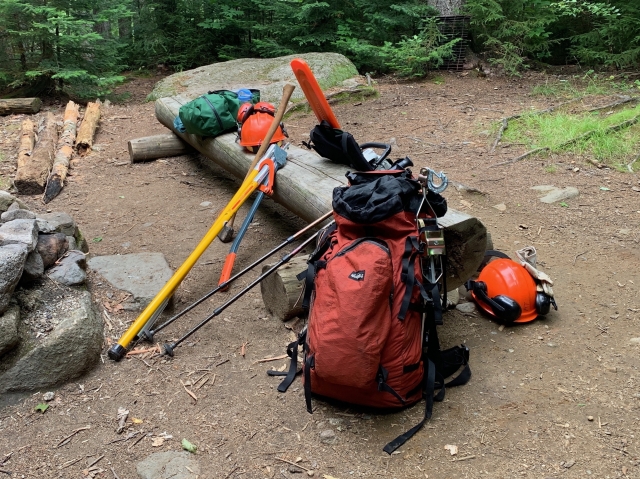
Everyone carried heavy tree-cutting equipment in and on top of backpacks. Their task was to cut down six hazardous trees which might fall, posing a risk to tent campers in the area of the shelter. Identifying the trees and cutting them down, using saws and tensioned ropes, took almost four hours of work.

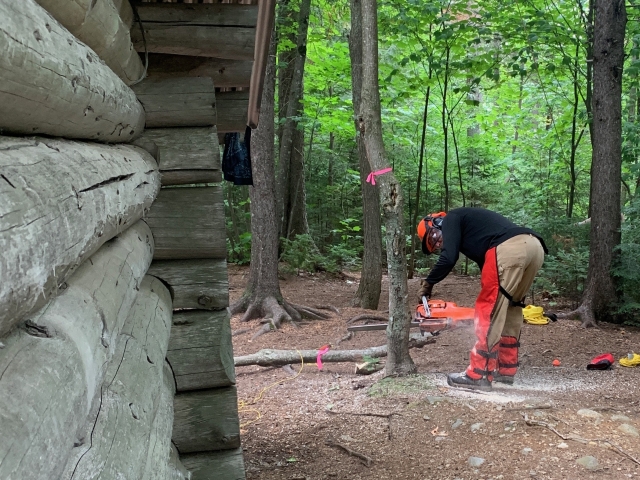
By the time the work was done, it had started to rain. The four packed up, said goodbye, and started the 1.5 mile journey back to the trailhead.

From left: Dan Hale, Paige Gregory, Tom Carr, Hawk Methany
As one thru hiker put it, “Maine is a giant stone with trees trying to grow on it.” Geology dictates the character of the Maine AT, creating streams to ford and random tangles of rocks, roots, and mud. But the hiker also encounters hundreds of bog bridges, and elegant flights of stairs made from nearby stones. As members of Allentown Hiking Club know, these and many other accommodations are the work of AT trail maintainers and builders, most of them volunteers from clubs along the trail.
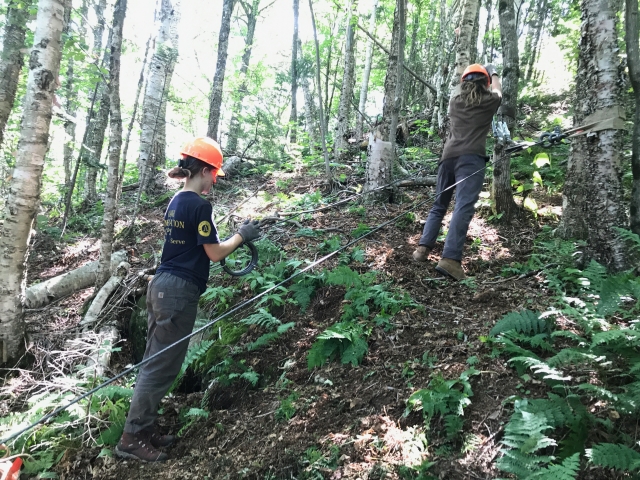
Moody Mountain, Maine. Maintainers rig a come-along and cables to position stone steps.
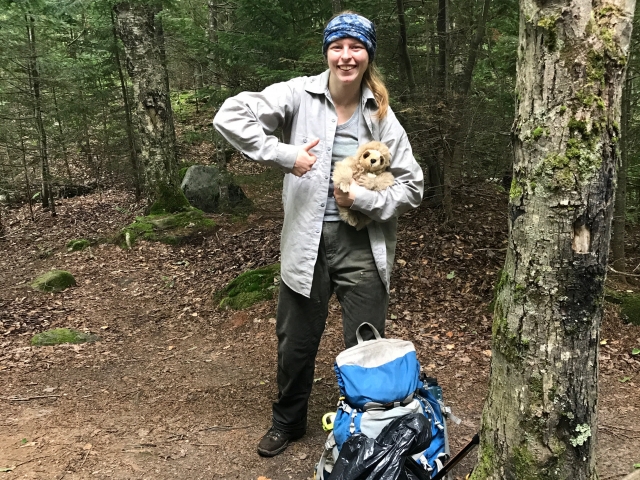
Bree is an Appalachian Mountain Club employee who tends to the campsites in New Hampshire and southern Maine.

May 10, 2019
Spring Is Here, Invasive Species are Starting to Sprout
By Karen Gradel
Spring Is Here, Invasive Species are Starting to Sprout
By Karen Gradel
Spring is here, the air is warming up, the birds are chirping and the plants are starting to sprout. But not all the plants emerging along the trail are a good sight. We have invasive plants along our section of the Appalachian Trail.
So what exactly is an invasive species? Not every plant that is introduced to a new region is invasive. Orange and Banana trees are not native to the US but after being brought here they are not invasive. According to Executive Order 13112 in 1999 a species is considered to be invasive if it meets two criteria: (1) it is nonnative to the ecosystem under consideration, and (2) its introduction causes, or is likely to cause, economic or environmental harm or harm to human health.
AHC has been concentrating mainly on two invasive species, Garlic Mustard and Japanese Stilt Grass during it’s Trail Maintenance. Both choke out local species and can create dense populations in as short 5 year period. They can eliminate the rare plants living in our section of the trail, such as the Pink Lady Slipper that can been found in Spring along the trail near Fort Franklin Road. Garlic Mustard also impacts the West Virginia White Butterfly. The butterfly mistakes Garlic Mustard for it’s host plant and the offspring laid on it don’t survive. Removing the plants at the right time is also important because both Japanese Stilt Grass and Garlic Mustard seeds can remain viable in the ground for five or more years.
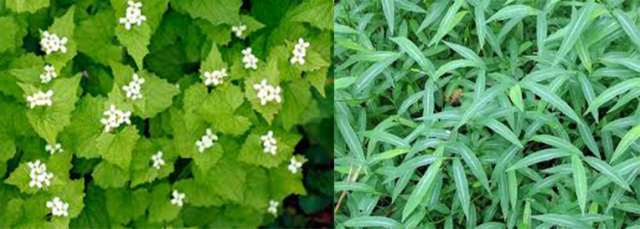
Garlic Mustard (left), Japanese Stilt Grass (right)
We have two maintenance hikes scheduled this quarter. One on April 13th at Lock 2 and the other on May 19th on the AT, where we will be continuing our battle with Garlic Mustard and other invasives. Don’t forget to take some Garlic Mustard home with you, because it’s edible. Check out this recipe for Garlic Mustard Pesto:
Garlic Mustard Pesto
Tip: Garlic Mustard is different from other greens in that the more mature plant leaves are less bitter than the young leaves, so try to use leaves from 2nd year plants of this Biennial.
Ingredients:
11 cups lightly packed garlic mustard leaves and tips, loosely chopped
1/4 cup pine nuts
1 garlic clove
1/3 cup grated parmesan cheese
1 cup extra virgin olive oil
1/2 teaspoon salt
1/2 teaspoon sugar
2 squeezes lemon juice
Directions:
In a blender, grind the garlic, pine nuts and parmesan. Add the garlic mustard. While blending, pour in a steady stream of the olive oil for 1 minutes, or until smooth. Add salt, sugar, lemon juice and pulse until mixed.
Also don’t forget to check out the revised AHC website. There’s easier navigation to documents. The calendar is improved with more functions and a quicker way to view past hikes. Thanks to Web Master Hal Wright for all the work he’s done updating our website to make it more functional and easier to explore all of our upcoming events.

February 19, 2019
Corridor Monitoring - What It Is and Why We Do It
by Lucy Cantwell
Corridor Monitoring - What It Is and Why We Do It
by Lucy Cantwell
Walking the boundaries of Appalachian Trail lands to prevent encroachments is an essential part of our responsibilities as a maintaining club.
It's the time of year for the Allentown Hiking Club to do our annual corridor monitoring. We talk about it a each meeting, but some of you may wonder, "What is this all about?" Here is a brief explanation of this annual activity.
A critical component of our duties as a maintaining club of the AT is corridor monitoring and boundary maintenance: keeping a close eye on the federal estate purchased to protect the Appalachian Trail. The AT "corridor" is the land owned by the National Park Service that extends a few hundred feet on either side of the trail. Corridor monitoring means walking along and examining the border of this NPS land and the adjacent lands ( for example, privately owned lands, state game lands, municipalities) to assure that all boundary markers are in place and no encroachments have occurred. This involves leaving the AT treadway and bushwhacking over rocks and through dense vegetation to locate "monuments," i.e., the markers installed by surveyors years ago to establish a line between NPS lands and that of neighboring landowners.

Encroachments, such as illegal dumping of waste, timber theft, rock piles, discarded machinery, hunting blinds, or evidence of incompatible uses such as ATVs are also documented. These discoveries are subsequently reported to the ATC (Appalachian Trail Conservancy) and corrective action is taken, if needed. During the monitoring we also post signage along the boundary lines, indicating which areas belong to the NPS. Volunteer monitors thus become the “eyes and ears” of state and federal landowning agencies. Monitoring helps assure the American public that its investment is being cared for and protected.
The Allentown Hiking Club monitors 35 tracts containing over 600 acres, which has 106 surveyor's monuments and 15 1/3 miles of exterior boundary. This is divided into 7 sections and is monitored by club members who commit to individual segments of about 4-7 miles each. Some of our monitors have been doing their sections for upwards of 20 years!
New volunteers are always welcome and encouraged to step up and join the action! If you think you might be interested in participating in the corridor monitoring, please contact the Monitor Coordinators listed on page 2 of the newsletter. We'd be happy to have you join one of the established monitors when they hike their section to collect the monitoring information. Also, keep an eye out for announcements on the AHC Forum, as monitors may post their hikes on the spur-of-the-moment, since good weather conditions are generally better for this activity. Be adventurous and come and see what it's all about!

POSTS BY TAG
POSTS BY MONTH